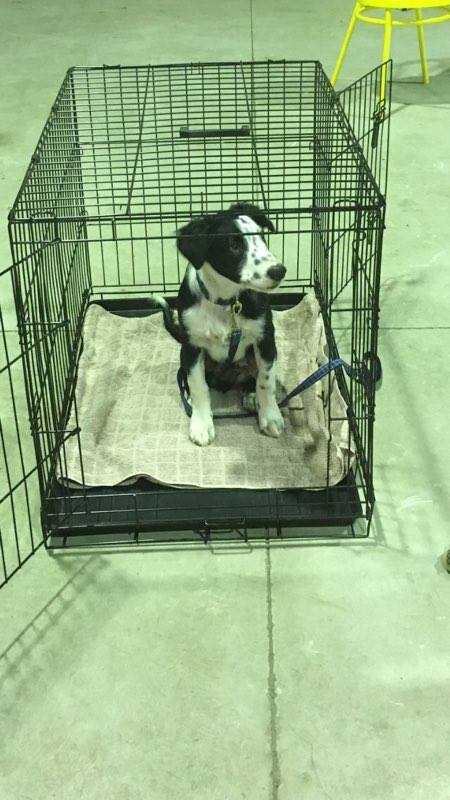 Crate Training
Crate Training
Dogs are den animals by nature so therefore, can feel secure and relaxed in an enclosed place and if trained, a crate can become a private sanctuary for your pet. Crate training your puppy or dog may be useful in many different situations – for example – travelling, vet visits, toilet training, or any time that your dog may need to be confined ie: if injured or after surgery.
Short Term Goal - To enter the crate with the door left open.
Step One: Buying a crate
1. Type - (Metal heavy duty, wire collapsible, plastic or fabric)
2. Size - (Is this big enough for your puppy/dog?)
3. Bedding - (Must be comfortable and cosy)
4. Water - (Must have water)
5. Treats and Toys - (Your puppy/dog's favourite toys)
6. Location - (Ensure the create is in an appropriate location)
Think about all of the above and ask yourself why you are teaching your puppy/dog to crate train? What sort of crate do you need? How big will my puppy get?
Use bedding that your puppy/dog is comfortable with or that has your scent on it to help him relax. Always ensure that there is access to fresh water. Use your puppy/dogs favourite toys to make him comfortable and ensure that initially the crate is in a location that is central to the house and where the family spend a lot of time.
Once you have chosen and purchased your crate and fitted it out with all of the required accessories to make it a comfortable place for your puppy/dog, you can move onto step two.
Step Two: Introduce your puppy to the crate
1. Place the crate in a location where you spend a lot of time. Your puppy may explore the create on his own.
2. Once your puppy is exploring the crate, continue to throw treats into the crate and each time he/she enters the crate start to use a verbal "cue" word by repeating the word such as "crate" or "bed".
3. Continue this until he/she calmly walks into the crate to get the treat. Once this is happening every time you toss the treat and say the cue word, you can move onto step three.
NOTE: This step may take a few minutes or it could take several days
Troubleshooting - if your dog doesn't explore the crate on his/her own:
- Whilst talking to him/her in a happy tone, bring him/her over to the crate
- Leave some treats nearby to encourage him/her to explore
- Place some treats just inside the door to encorage him/her to enter the crate
- Throw the treats all the way in so he/she has to enter the crate to get them. (Don't force him to enter if he refuses to. He will get used to it. If he isn't food driven, try tossing his favourite play toy)
Medium Term Goal - Go into the crate on his/her own and have the door closed for one minute.
Step Three: Feed meals inside the crate
1. If he/she is readily entering the crate when you approach, place his food bowl in all the way at the back of the crate and say your cue word
2. Once he/she will stand comfortably inside and eat his meal, close the door while he/she is eating
3. For the first time, as soon as he/she finishes eating, open the door
4. Each time you feed after this first time, leave the door closed for a little longer until eventually he/she is in the crate for about 10 minutes after he/she finishes eating.
5. Before opening the door each time, ask your puppy to sit and give him/her a treat through the top of the crate. Open the door and invite him/her out and use a cue word such as "free", "out", "exit" or "break". Once this is happening often and comfortably, you can move onto step four.
NOTE: This step could take up to a couple of weeks depending on the dog and the training frequency.
Troubleshooting - If he/she is still a little reluctant about entering the crate, place his/her food bowl only as far as he is willing to go. Each time you feed him/her, place the bowl a little further in until he/she is in all the way without being nervous or anxious. Don't rush this step. Let your puppy do it at their own pace.
If your puppy starts to whine when the door is closed, it may be because the time in the crate was increased too quickly. Don't let him/her out of the crate until he/she stops crying or whining, or he/she will learn that when he/she cries or whines, he/she will be let out. Next time, try leaving him/her in for a shorter length of time.
Step Four - Leaving your puppy in the crate for longer periods
If step three is occuring with no signs of anxiety or fear, you can continue onto the below step:
1. Go back to calling your puppy over to the crate, using your cue word for enter and throwing the treat into the crate. After your puppy is inside, praise and close the door.
2. Sit quietly near the crate for 5-10 minutes and then leave the room for another couple of minutes. Return and sit quietly again for another couple of minutes and then let your puppy out.
3. This process needs to be repeated as often throughout the day as possible, gradually making the time you leave him/her in the crate and the length of time you are out of the room longer.
4. Once your puppy stays quietly in the crate for about 30 minutes with you mostly out of the room, without any anxiety, you can being to leave him crated while you make a short trip away from the home. Continue to step five.
Step Five - Going out and leaving him in the crate
1. Only attempt this stage after step 4 has prograssed without any fear or anxiety.
2. Ask your puppy to enter the crate using your usual command and treat
3. Leave a few of the favourite toys with him/her as well. Freezing a stuffed rubber "Kong" chew toy will occupy your puppy for a while after you leave.
4. Crate him/her anywhere from 5 to 20 minutes prior to leaving. Try to vary the time that he/she is in the crate before you leave.
5. When you leave, make it straight forward and matter-of-fact. Don't be emotional or prolong your departure. Praise him briefly, give him a treat and then leave quietly.
6. When you get home, he will be excited but don't reward him by reponding excitedly or with enthusiasm. Keep your arrival low key to avoid his anxiety increasing over when you will return home.
Step Six - Crating your dog at night time.
1. Start by putting the crate in your bedroom next to your bed, or in the hallway near your bedroom
2. Ask your puppy to enter the crate using your cue word for enter and giving him/her a treat
3. Depending on your puppy or dogs age, he may not be able to go the whole night without needing to go to the toilet, so with him/her near you, you will be able to hear if he/she needs to go for a walk
4. Once your puppy is sleeping comfortably all through the night in the crate near you, you can begin to slowly move the crate to a position of the house that suits you.
Troubleshooting - If your puppy starts whining in the crate at night, it may mean that he/she needs to go to the toilet. If you have followed the training plan above, and he/she hasn't been rewarded for whining by being let out of the crate, he/she shouldn't whine for attention. If you think that he/she shouldn't need a toilet break, try to ignore the whining. If he/she is testing you, he/she should stop whining soon. If the whining continues after several minutes, use the cue word that you use for his/her toileting. If he/she becomes excited, you should take him/her outside. Make sure that this is just a toilet trip, not playtime. After he/she eliminates, bring he/she back inside and put he/she back into the crate using your enter cue word and a treat.
Written by Emma Pearse









